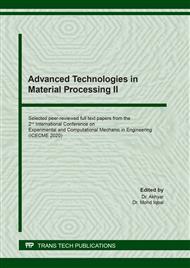[1]
M.C. Bahalkar, N.L. Shegokar, Modelling and analysis of helical coil spring under different load condition by using FEM, International Journal of Engineering Sciences & Research Technology, 6 (2017) 444–451.
Google Scholar
[2]
G. Yazar, Design and Analysis of Helical Coil Spring Forms for Independent Suspensions of Automobiles, Thesis, Middle East Technical University, (2015).
Google Scholar
[3]
V.B. Vishwa, V. Deepak, Static analysis of slotted springs, Proceedings of 2016 International Conference on Automatic Control and Dynamic Optimization Techniques (ICACDOT), (2016), 455-459.
DOI: 10.1109/icacdot.2016.7877627
Google Scholar
[4]
Y. Prawoto, M. Ikeda, S.K. Manville, A. Nishikawa, Design and failure modes of automotive suspension springs, Engineering Failure Analysis, 15 (2008) 1155-1174.
DOI: 10.1016/j.engfailanal.2007.11.003
Google Scholar
[5]
T.M. Mulia, S.J. Kadam, V.S. Kengar, Finite element analysis of helical coil compression spring for three wheeler automotive front suspension, International Journal of Mechanical and Industrial Engineering, 2 (2012) 74-77.
DOI: 10.47893/ijmie.2013.1130
Google Scholar
[6]
S.R. Burgul, A.P. Kulkarni, Fatigue analysis for helical compression spring for determining design alternatives for enhanced life and performance, International Journal for Technological Research in Engineering (IJTRE), 2 (2015) 1070-1078.
Google Scholar
[7]
T.E. Putra, Husaini, M.N. Machmud, Predicting the fatigue life of an automotive coil spring considering road surface roughness, Engineering Failure Analysis, 116 (2020) 104722.
DOI: 10.1016/j.engfailanal.2020.104722
Google Scholar
[8]
T.E. Putra, Husaini, H. Prakasa, Prediction of the fatigue life of the SAE 5160 carbon steel coil spring based on strain-life approach, Key Engineering Materials, 841 (2020) 381-386.
DOI: 10.4028/www.scientific.net/kem.841.381
Google Scholar
[9]
W. Ramberg, W.R. Osgood, Description of stress-strain curves by three parameters, National Advisory Committee for Aeronautics, (1943).
Google Scholar
[10]
nCode, GlyphWorks, nCode International, Ltd., Sheffield, (2018).
Google Scholar
[11]
M. Aykan, M. Çelik, Vibration fatigue analysis and multi-axial effect in testing of aerospace structures, Mechanical Systems and Signal Processing, 23 (2009) 897-907.
DOI: 10.1016/j.ymssp.2008.08.006
Google Scholar
[12]
T.E. Putra, Husaini, Identifying strain signal characteristics of automotive suspension system subjected to road surface vibrations, AIP Conference Proceedings, 1983 (2018).
DOI: 10.1063/1.5046239
Google Scholar
[13]
T.E. Putra, Husaini, H. Prakasa, I. Hasanuddin, M. Rizal, M.N. Machmud, Fatigue life assessments of the SAE 5160 carbon steel subjected to uphill and downhill roads strains, Defect and Diffusion Forum, 402 (2020) 33-38.
DOI: 10.4028/www.scientific.net/ddf.402.33
Google Scholar


